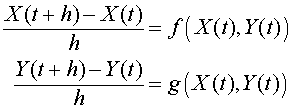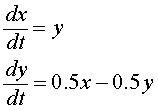|
|
Math 122 - Calculus for Biology II |
|
|---|---|---|
|
|
San Diego State University -- This page last updated 26-Aug-01 |
|
|
|
Math 122 - Calculus for Biology II |
|
|---|---|---|
|
|
San Diego State University -- This page last updated 26-Aug-01 |
|
This section extends our work on two dimensional differential equations to numerical methods and some graphical techniques for understanding their behavior. The section begins by showing numerical methods for solving the systems of differential equations developed in the sections on the Lotka-Volterra predator-prey system and the model for competition of two species of yeast. These numerical solutions allow finding the best parameters that fit the data of the mathematical model (though these nonlinear least squares fitting techniques are beyond the scope of this course, so are simply outlined using Excel's solver routine).
In the previous section, a mathematical model for the competition of two species of yeast was presented along with an equilibrium analysis. The mathematical model for competition of two species was given by the following system of differential equations

In that section, the data for the Gause experiments on the two yeast species S. cerevisiae and S. kephir were presented. The parameters a1, a2, b1, and b2 were computed by using a nonlinear least squares fit to the data for the experiments where the species were grown in pure cultures. The parameters a1 and b1 represent the growth rate of the species S. cerevisiae and S. kephir, respectively, while the parameters a2 and b2 represent the intraspecies competition of S. cerevisiae and S. kephir, which can be used to find the carrying capacity of these species growing individually. The question remains on how we can find the remaining parameters a3 and b3, which represent the interspecies competition.
The data we want to match is presented again below:
|
|
0 |
1.5 |
9 |
10 |
18 |
18 |
23 |
25.5 |
27 |
38 |
42 |
45.5 |
47 |
|
|
0.375 |
0.92 |
3.08 |
3.99 |
4.69 |
5.78 |
6.15 |
9.91 |
9.47 |
10.57 |
7.27 |
9.88 |
8.3 |
|
|
0.29 |
0.37 |
0.63 |
0.98 |
1.47 |
1.22 |
1.46 |
1.11 |
1.225 |
1.1 |
1.71 |
0.96 |
1.84 |
These data are more scattered than the monocultures. If we make an assumption that these cultures first approach a coexistence equilibrium near Xe = 9 and Ye = 1.8. Recall that the coexistence equilibrium is given by

Since the monoculture studies gave the parameters a1 = 0.2586, a2 = 0.02030, b1 = 0.05744, and b2 = 0.009768, we can estimate values of a3 and b3 from the equations above and estimates of the coexistence equilibrium. The simultaneous solution of these two nonlinear equations (using a program such as Maple's solve routine) give either a3 = 0.0422 and b3 = 0.00443 or a3 = 0.044 and b3 = 0.00451, which are solutions that are close enough for initial estimates in a nonlinear least squares fit to the simulation of the data in the table above.
Euler's Method for a System of Differential Equations
So how do we simulate the data using our competition model? The simplest and most intuitive method for simulating any 2-D system of differential equations is to use Euler's method, which we developed earlier this semester for solving a nonlinear differential equation. The idea behind Euler's method is to use the definition of the derivative

but choose a specific value of h, the stepsize of the iteration scheme, instead of finding the limit as h becomes very small. This results in our differential equations changing from a system of continuous equations involving two unknown functions and their derivatives to a discrete dynamical system of two unknown variables, which are easily simulated using the computer.
Fix the stepsize h, then use the discretized form of our system of differential equations above. The result is the following system of equations:

If we define X(t+h) = Xn+1, X(t) = Xn, Y(t+h) = Yn+1, Y(t) = Yn, then after a little algebra, the system of equations above can be written
Thus, by knowing the initial values X0 and Y0 and the stepsize h along with the functions f(Xn, Yn) and g(Xn, Yn), then we can easily compute the subsequent values Xn and Yn for n = 1, 2, 3, ... This gives us a numerical approximation to the solution of the system of differential equations, and this iteration scheme is known as Euler's method for solving a 2-D system of differential equations.
Example 1: Consider the system of differential equations given by

with the initial conditions
Use Euler's method with a stepsize of h = 0.5 to approximate the solution at t = 2.
Solution: From the information above the Euler's iteration scheme with a stepsize of h for this system of differential equations is given by
with the initial values x0 = 1 and y0 = 2. We need to perform 4 iterations of this scheme to obtain the approximation at t = 2. The first iteration, which approximates the solution at t = 0.5, is given by
x1 = x0 + 0.5y0 = 1 + 0.5(2) = 2
y1 = y0 + 0.5(0.5x0 - 0.5y0) = 2 + 0.5(0.5(1) - 0.5(2)) = 1.75
This process is repeated giving the approximate solution at t = 1 as
x2 = x1 + 0.5y1 = 2 + 0.5(1.75) = 2.875
y2 = y1 + 0.5(0.5x1 - 0.5y1) = 1.75 + 0.5(0.5(2) - 0.5(1.75)) = 1.8125
and the approximate solution at t = 1.5 as
x3 = x2 + 0.5y2 = 2.875 + 0.5(1.8125) = 3.78125
y3 = y2 + 0.5(0.5x2 - 0.5y2) = 1.8125 + 0.5(0.5(2.875) - 0.5(1.8125)) = 2.078125
and the approximate solution at t = 2 as
x4 = x3 + 0.5y3 = 3.78125 + 0.5(2.078125) = 4.8203
y4 = y3 + 0.5(0.5x3 - 0.5y3) = 2.0781 + 0.5(0.5(3.7813) - 0.5(2.0781)) = 2.5039
These calculations are tedious by hand but easily performed by a computer. As we saw with the discrete dynamical systems in Math 121, these computations are very easy to set up and evaluate using spreadsheet software, such as Excel. The spreadsheet for this example is available through this hyperlink.
The solution of this system of differential equations is
[1]